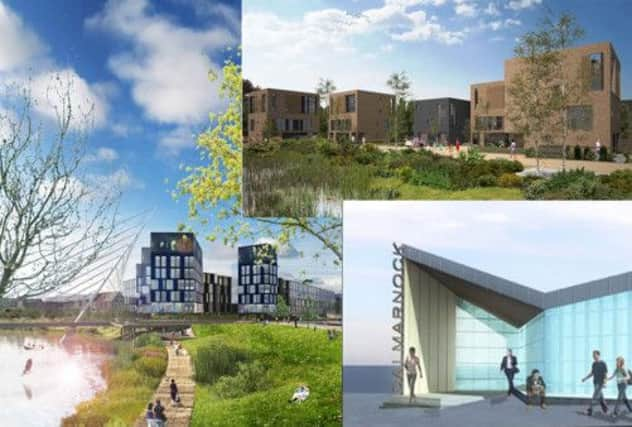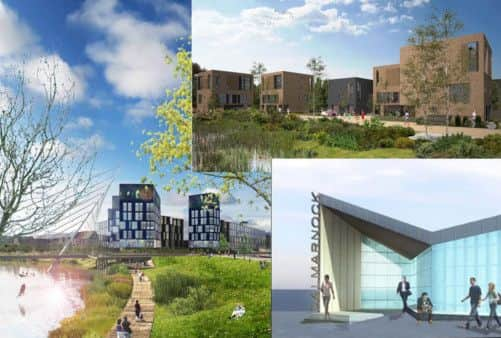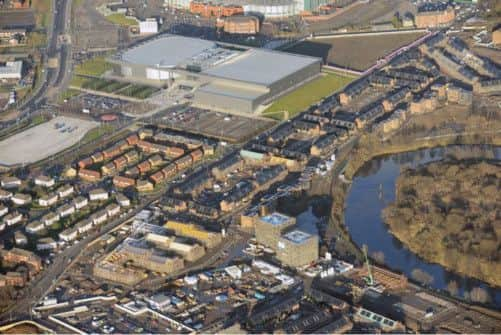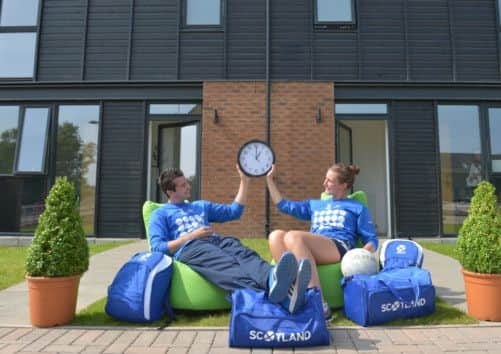Glasgow 2014: First glimpse of Athletes Village


• 6,500 athletes and officials will move in for the Games
• 260,000 items of furniture been shipped from London
• Construction started on the project in 2011


The 6,500 athletes and officials who will move into the specially-built village in Dalmarnock will be sitting and sleeping on sofas, beanbags and beds previously graced by those taking part in last year’s London Olympics.
However, the re-located furniture will be in new houses featuring large bedrooms, big attic windows and solar panels.
Advertisement
Hide AdAdvertisement
Hide AdIn stark contrast to a near disaster at the 2010 Delhi games, when the Scotland team hesitated over whether to move into an unfinished athletes village, officials in Glasgow said 85 per cent of its village was already complete.
The site, whose builders have described as one of the most significant new urban developments in the UK, is largely a giant housing estate. During the Games, it will be have four zones with Scottish-flavoured names – Clan, Castle, Mountain and Loch.


The houses will go on the market or become available to rent from November 2014 with its streets likely to be named after some of the 71 countries competing.
There are 13 types of houses, ranging from three-storey terraces to seven-storey flats. Prices are expected to start at less than £100,000 with residents enjoying half the normal fuel bills because heating is provided by a centralised plant.
The site also includes a 120-bed care home for the elderly, which has a lift linking its two floors, that will be used by Parasports athletes.
Temporary buildings to be constructed on the site next year, such as a 2,000-seat, 24-hour dining hall, medical centre and gym, will be dismantled again before the village becomes a residential area.


The sofas and beds are among 260,000 items of furniture that have been shipped by sea from London, which also include blackout curtains, coat stands and wardrobes.
There are even extendable mattresses for the tallest athletes – one of which may have been slept on by superstar sprinter Usain Bolt.
Advertisement
Hide AdAdvertisement
Hide AdKitchens will not be installed in the houses until after the games to minimise the chance of food poisoning
2006 bronze medal winning gymnast Adam Cox, 26, from Livingston, who visited the site yesterday, said: “I think this sets a new bar. It’s amazing that it’s almost complete with a year still to go.
“The design has benefited from input from athletes throughout, such as the size of the rooms and being able to have the whole Scotland team living in the same street.”
Lynsey Gallagher, 21, from East Kilbride, who is hoping to be selected for the netball team for the Games, said: “I had no idea what it would be like when I came here, but I’ve found the rooms are nice and spacious, with big windows.
Ms Gallagher, a member of the Scotland squad, which is rated 13th in the world, said: “Having somewhere comfortable to sleep is important, and a place to chill out and kick back that is not cluttered.”
The site, which hugs the northern bank of a loop of the river, is adjacent to the Emirates Arena, hosting badminton, and the Sir Chris Hoy Velodrome.
Shuttle buses will take athletes to other venues, with no parking on the site.
Glasgow 2014 chief executive David Grevemberg said: “The Glasgow Organising Committee promised we would have an athlete-centred and sport-focused Games and this is really epitomised by the athletes’ village.
Advertisement
Hide AdAdvertisement
Hide Ad“We have consulted all the way along the project to make sure that this really does become a home from home where athletes can relax between training and competition.”
The 11-day games begin on 23 July next year.
Team Scotland general team manager Elinor Middlemiss said: “The village is the heartbeat of every Games, providing that important home from home for all the athletes as they prepare for one of the most important performances of their lives, as well as providing a base for Team Scotland operations.”
Archie Graham, executive member for the Commonwealth Games at the City Council, said: “For a few weeks, thousands of athletes will call Glasgow home and we believe they will remember both Glasgow and the athletes’ village as a fantastic place to stay.”
Water everywhere as area’s industrial legacy is honoured
THE Athletes Village is built on a former rundown housing site which was once an industrial area that produced soap and iron.
Excavations have found the remains of what is thought to be among Scotland’s oldest water pumping stations, which was designed by James Watt.
Water is also playing an important part in the site’s current renaissance, with a canal-like drainage channel to be constructed between the village and the Clyde.
This will help prevent flooding by slowing the flow of rainwater into the river from the village.
Calum Murray, managing director of CCG Homes, one of the village’s developers, said: “Rather than hide the channel we decided to make a feature of it as part of the site.”
Advertisement
Hide AdAdvertisement
Hide AdA new bridge will be built across the river to link the village with a £5 million woodland park to be created on the Cuningar Loop on the southern bank.
Some 10,000 trees will help transform the derelict former industrial site, which is expected to open soon after the Commonwealth Games.
The project, which involves Forestry Commission Scotland, Clyde Gateway and South Lanarkshire Council, aims to attract more than 100,000 visitors within the next eight years.
Environment minister Paul Wheelhouse, who visited the site on Thursday, said: “For over 200 years, this area of land has been used for mixed industrial use. That is all about to change and a green retreat for local people will become a reality.”
An £85m wildlife park is also planned for the area.
Wildside World will feature three giant biospheres housing a host of animal and plant species.
The Commonwealth Game’s athletes village in numbers
700 homes
86 acres site
13 house types
97,000 cubic metres decontaminated soil reused
4,500 athletes resident
2,000 officials resident
390,000 meals served
2,000 menu items
500,000 pieces of fruit
11,600kg mushrooms
10,000 loaves bread
30,000 towels
26,000 bed sheets
12,600 pillow cases
2 days towels changed
4 days bed sheets changed
20,000 toilet rolls
100,000 bin liners
1,400 litres liquid soap